Personification
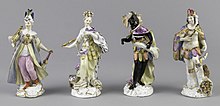
Personification is the representation of a thing or abstraction as a person. It is, in other words, considered an embodiment or an incarnation.
In many
Generally, personifications lack much in the way of narrative
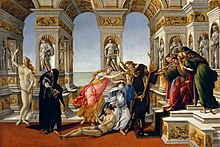
Personifications are very common elements in allegory, and historians and theorists of personification complain that the two have been too often confused, or discussion of them dominated by allegory. Single images of personifications tend to be titled as an "allegory", arguably incorrectly.[11] By the late 20th century personification seemed largely out of fashion, but the semi-personificatory superhero figures of many comic book series came in the 21st century to dominate popular cinema in a number of superhero film franchises.
According to Ernst Gombrich, "we tend to take it for granted rather than to ask questions about this extraordinary predominantly feminine population which greets us from the porches of cathedrals, crowds around our public monuments, marks our coins and our banknotes, and turns up in our cartoons and our posters; these females variously attired, of course, came to life on the medieval stage, they greeted the Prince on his entry into a city, they were invoked in innumerable speeches, they quarreled or embraced in endless epics where they struggled for the soul of the hero or set the action going, and when the medieval versifier went out on one fine spring morning and lay down on a grassy bank, one of these ladies rarely failed to appear to him in his sleep and to explain her own nature to him in any number of lines".[12]
History
Classical world
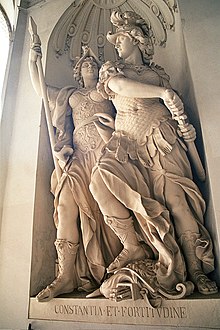
Personification as an artistic device is easier to discuss when belief in the personification as an actual spiritual being has died down;
Personification is found very widely in classical literature, art and drama, as well as the treatment of personifications as relatively minor deities, or the rather variable category of
Personification in the Bible is mostly limited to passing phrases which can probably be regarded as literary flourishes,[18] with the important and much-discussed exception of Wisdom in the Book of Proverbs, 1–9, where a female personification is treated at some length, and makes speeches.[19] The Four Horsemen of the Apocalypse from the Book of Revelation can be regarded as personification figures, although the text does not specify what all personify.[20]
According to James J. Paxson in his book on the subject "all personification figures prior to the sixth century A.D. were ... female";
Pairs of
Lucian (2nd century AD) records a detailed description of a lost painting by Apelles (4th century BC) called the Calumny of Apelles, which some Renaissance painters followed, most famously Botticelli. This included eight personifications of virtues and vices: Hope, Repentance, Perfidy, Calumny, Fraud, Rancour, Ignorance, Suspicion, as well as two other figures.[26]
Platonism, which in some manifestations proposed systems involving numbers of spirits,[27] was naturally conducive to personification and allegory, and is an influence on the uses of it from classical times through various revivals up to the Baroque period.
Literature
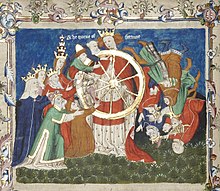
According to Andrew Escobedo, "literary personification marshalls inanimate things, such as passions, abstract ideas, and rivers, and makes them perform actions in the landscape of the narrative."
A medieval creation was the
The major works of Middle English literature had many personification characters, and often formed what are called "personification allegories" where the whole work is an allegory, largely driven by personifications. These include Piers Plowman by William Langland (c. 1370–90), where most of the characters are clear personifications named as their qualities,[33] and several works by Geoffrey Chaucer, such as The House of Fame (1379–80). However, Chaucer tends to take his personifications in the direction of being more complex characters and give them different names, as when he adapts part of the French Roman de la Rose (13th century). The English mystery plays and the later morality plays have many personifications as characters, alongside their biblical figures. Frau Minne, the spirit of courtly love in German medieval literature, had equivalents in other vernaculars.
In
In Elizabethan literature many of the characters in Edmund Spenser's enormous epic The Faerie Queene, though given different names, are effectively personifications, especially of virtues.[36] The Pilgrim's Progress (1678) by John Bunyan was the last great personification allegory in English literature, from a strongly Protestant position (though see Thomson's Liberty below). A work like Shelley's The Triumph of Life, unfinished at his death in 1822, which to many earlier writers would have called for personifications to be included, avoids them, as does most Romantic literature,[37] apart from that of William Blake.[38] Leading critics had begun to complain about personification in the 18th century, and such "complaints only grow louder in the nineteenth century".[39] According to Andrew Escobedo, there is now "an unstated scholarly consensus" that "personification is a kind of frozen or hollow version of literal characters", which "depletes the fiction".[40]
Visual arts
Personifications, often in sets, frequently appear in medieval art, often illustrating or following literary works. The virtues and vices were probably the most common, and the virtues appear in many large sculptural programmes, for example the exteriors of Chartres Cathedral and Amiens Cathedral. In painting, both virtues and vices are personified along the lowest zone of the walls of the Scrovegni Chapel by Giotto (c. 1305),[41] and are the main figures in Ambrogio Lorenzetti's Allegory of Good and Bad Government (1338–39) in the Palazzo Pubblico of Siena. In the Allegory of Bad Government Tyranny is enthroned, with Avarice, Pride, and Vainglory above him. Beside him on the magistrate's bench sit Cruelty, Deceit, Fraud, Fury, Division, and War, while Justice lies tightly bound below.[42] The so-called Mantegna Tarocchi (c. 1465–75) are sets of fifty educational cards depicting personifications of social classes, the planets and heavenly bodies, and also social classes.[43]
A new pair, once common on the portals of large churches, are
When not illustrating literary texts, or following a classical model as Botticelli does, personifications in art tend to be relatively static, and found together in sets, whether of statues decorating buildings or paintings, prints or media such as porcelain figures. Sometimes one or more virtues take on and invariably conquer vices. Other paintings by Botticelli are exceptions to such simple compositions, in particular his
Theory
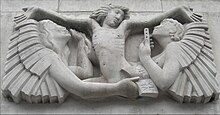
Around 300 BC,
From the late 16th century theoretical writers such as Karel van Mander in his Schilder-boeck (1604) began to treat personification in terms of the visual arts. At the same time the emblem book, describing and illustrating emblematic images that were largely personifications, became enormously popular, both with intellectuals and artists and craftsmen looking for motifs.[53] The most famous of these was the Iconologia of Cesare Ripa, first published unillustrated in 1593, but from 1603 published in many different illustrated editions, using different artists. This set at least the identifying attributes carried by many personifications until the 19th century.[54]
From the 20th century into the 21st, the past use of personification has received greatly increased critical attention, just as the artistic practice of it has greatly declined. Among a number of key works, The Allegory of Love: A Study in Medieval Tradition (1936), by C. S. Lewis was an exploration of courtly love in medieval and Renaissance literature.[55]
Innovation
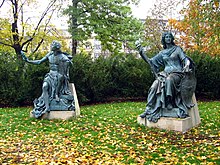
The classical repertoire of virtues, seasons, cities and so forth supplied the majority of subjects until the 19th century, but some new personifications became required. The 16th century saw the new personification of the Americas and made the four continents an appealing new set, four figures being better suited to many contexts than three. The 18th-century discovery of Australia was not so quickly followed by an addition to the set, if only for reasons of geometry; Australia is not included in the continents at the corners of the Albert Memorial (1860s). This does have a set of three-figure groups representing agriculture, commerce, engineering and manufacturing, typical of the requirements for large public schemes of the period.[56] A rather late example is the Alexander Hamilton U.S. Custom House in New York City (1901–07), which has large groups for the four continents by the entrance, and 12 figures personifying seafaring nations from history high on the facade.
The invention of
National personifications
A number of national personifications stick to the old formulas, with a female in classical dress, carrying attributes suggesting power, wealth, or other virtues.[59]
But, sometimes alongside these formal figures, a new type of national personification has arisen, typified by John Bull (1712) and Uncle Sam (c. 1812). Both began as figures in more or less satirical literature but achieved their prominence when taken into political cartoons and other visual media. The post-revolutionary Marianne in France, official since 1792, is something of a mixture of styles, sometimes formal and classical, at others a woman of the streets of Paris personified.[65] The Dutch Maiden is one of the earliest of these figures, and was mainly visual from the start, her efforts to repulse unwelcome Spanish advances shown in 16th-century popular prints.[66]
See also
- Anthropomorphism
- Allegorical sculpture
- Heraldry
- Mascot
- Moe anthropomorphism; personification style mainly used in anime and manga
- Pathetic fallacy, the literary device involving ascribing human emotion and conduct to non-human objects in the natural world
- Tropical cyclone naming
Notes
- ^ "Definition of PERSONIFICATION". www.merriam-webster.com. 1 April 2024. Retrieved 4 April 2024.
- ^ Hall, 128–130
- ^ Hall, 122
- ^ Hall, 336–337
- ^ Hall, 216
- ^ Paxson, 6–7
- ^ Hall, 321
- ^ Hall, 216; the example here is the Muses, daughters of Apollo and Mnemosyne, herself the personification of Memory.
- ^ Hall, 128, speaking of the Four Seasons, but the same is true for example of the personification of Africa (same page).
- ^ Melion and Remakers, 5; Gombrich, 1 (of PDF)
- ^ Melion and Remakers, 2–13; Paxson, 5–6. See also Escobedo, Ch. 1
- ^ Gombrich, 1 (of PDF)
- ^ Paxson, 6–7; Escobedo, Introduction
- ^ Although given the persistence of ideas from Neoplatonism and folk religion this cannot be entirely certain. See, for example Gombrich 5–6 (on pdf)
- ISBN 0 7141 1442 1
- ^ Escobedo, Ch. 1 on daemons
- ^ Smith, 93–105
- ^ "the mountains and the hills before you shall break forth into singing, and all the trees of the field shall clap their hands", Book of Isaiah, 55:12
- ISBN 1351884360, 9781351884365. Subject of the whole book, but see Ch. 1
- ^ Paxson, 6
- ^ Hall, 128, 265
- ^ Gombrich, 2 (of PDF)
- Calendar of 354 and the slightly later Esquiline Treasure provide examples, though the choice of 4th city varies between Antioch and Trier.
- ^ Sear, 36–42, 46–48, 49–51
- ^ Lightbown, Ronald, Sandro Botticelli: Life and Work, 234, 1989, Thames and Hudson
- ^ Escobedo, Ch. 1
- ^ Escobedo, Introduction
- ^ Hall, 336, with much more in Paxson.
- ^ Hall, 127–128
- ^ Hall, 336; see "Further reading" for some recent examples of the very extensive literature on these.
- ^ Melion and Remakers, 99–101
- ^ Hall, 310
- ^ Melion and Remakers, 73–77
- ^ Melion and Remakers, 121–122
- ^ "All the commonplace figures of poetry, tropes, allegories, personifications, with the whole heathen mythology, were instantly discarded" according to William Hazlitt in "On the Living Poets" in Lectures on the English Poets, 1818
- ISBN 0838631762, 9780838631768, google books
- ^ Escobedo, Introduction
- ^ Escobedo, Ch. 1. He does not share this view. In particular, personifications mostly remain tied to a single character trait, that of embodying their quality.
- ^ Hartt, 64
- ^ Hartt, 116–119
- ISBN 0931537150
- ^ Hall, 94
- ^ Hartt, 332–333
- ^ Bartrum, 188
- ^ Hartt, 662
- ^ Bartrum, 188, says Melencolia I "must be the most written-about image in the history of art", but at least the Botticellis must run it close.
- ^ Paxson, 12
- ^ Paxson, 16–19
- ^ Paxson, 23
- ^ Melion and Remakers, 13–26
- ^ Hall, 337
- ^ Paxson, 1–2 and passim; Escobedo, Introduction
- ^ These were all given consideration at the highest levels. The designs for the continents had "changes [which] may (although there is no evidence of it) reflect the promptings of 'statesmanlike' discretion. Participation in the guidance of America's progress was relinquished by the figure of Canada and it was left wholly to the United States. In the group of Europe, the link of olive leaves between France and England was dropped, as was the gesture indicating England's reception of the Bible of the Reformation from Germany, and each of the national figures was more isolated. In 'Africa', Egypt, instead of listening to the counsels of Britain, herself instructed Nubia." 'Albert Memorial: The memorial' Archived 2014-11-04 at the Wayback Machine, Survey of London: volume 38: South Kensington Museums Area (1975), 159–176. Accessed: 22 May 2019
- ^ Melion and Remakers, 30
- ^ Jackson, Nicola, Building the BBC: a return to form, 28, 2004, BBC
- ^ Heuer, 48–50
- ^ Sear, 39
- ISBN 0199883076, 9780199883073
- ^ Higham, 59; text of Liberty online
- ^ Higham, 59–61
- ISBN 184383541X, 9781843835417, google books Archived 2022-12-06 at the Wayback Machine; "Column to Liberty" Archived 2019-05-29 at the Wayback Machine, National Trust.
- ^ Heuer, 43–44, 48–50
- ^ Hubert de Vries, "The Dutch Virgin: Symbols of State of the Netherlands" Archived 2018-12-13 at the Wayback Machine
References
- ISBN 0714126330
- Escobedo, Andrew, Volition's Face: Personification and the Will in Renaissance Literature, 2017, University of Notre Dame Press, ISBN 0268101698, 9780268101695, google books
- Gombrich, Ernst, "Personification", in R. R. Bolgar (ed.), Classical Influences in European Culture AD 500–1500, 1971, Cambridge UP, PDF
- Hall, James, Hall's Dictionary of Subjects and Symbols in Art, 1996 (2nd edn.), John Murray, ISBN 0719541476
- ISBN 0500235104
- Heuer, Jennifer, "Gender and Nationalism" in Nations and Nationalism: A Global Historical Overview, Eds Guntram H. Herb, David H. Kaplan, 2008, ABC-CLIO, ISBN 1851099085, 9781851099085, google books
- Higham, John (1990). "Indian Princess and Roman Goddess: The First Female Symbols of America", Proceedings of the American Antiquarian Society. 100: 50–51, JSTOR or PDF
- Melion, Walter, Remakers, Bart, Personification: Embodying Meaning and Emotion, 2016, BRILL, ISBN 9004310436, 9789004310438, google books
- Paxson, James J., The Poetics of Personification, 1994, Cambridge University Press, ISBN 0521445396, 9780521445399, google books
- Sear, David, Roman Coins and Their Values, Volume 2, 46–48, 49–51, 2002, Spink & Son, Ltd, ISBN 1912667231, 9781912667239, google books
- ISBN 9004194177, 9789004194175, google books
Further reading
- Jennifer O’Reilly: Studies in the Iconography of the Virtues and Vices in the Middle Ages. New York/London 1988.
- Emma Stafford: Worshipping virtues. Personification and the Divine in Ancient Greece. London 2000.
- Emma Stafford, Judith Herrin (eds.): Personification in the Greek world. From Antiquity to Byzantium. Aldershot/Hampshire 2005.
- Tucker, Shawn R., The Virtues and Vices in the Arts: A Sourcebook, 2015, Wipf and Stock Publishers, ISBN 1625647182, 9781625647184
- Bart Ramakers, Walter Melion, eds., Personification: Embodying Meaning and Emotion, 2016, BRILL, ISBN 9789004310438, google books
